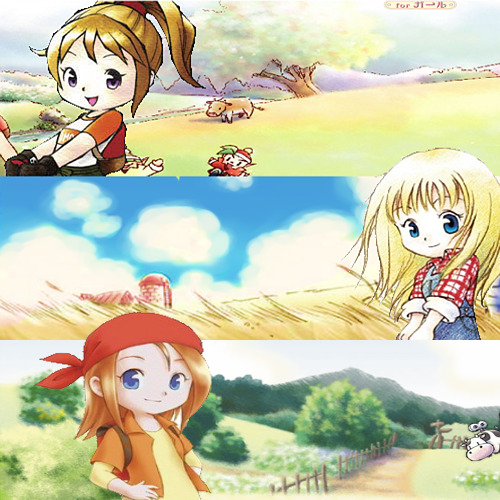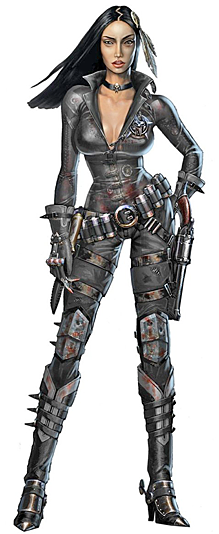Representation and Design Trends in Games
An essay explaining the necessity, and value, in advancing representation of minorities in video games.

Representation and Design Trends in Games
by Claire Bolton

“Diversity” - FemShep, Lee Everett, Serena, Maya, and Faith (Lee)
“Diversity” has become a buzzword of late. From changing corporate hiring practices, to expanding academic opportunities, institutions around the globe are pushing more and more toward egalitarianism even in spite of all the virulent cases of reactionary backlash cropping up. Typically, there can be seen at least three areas of increased diversification: increased representation of minorities in the workforce, greater efforts to cater to minority consumers, and concerted efforts to positively depict minorities in media. The games industry, too, is following along with this trend. Or rather, it appears to be. Controversies like Gamergate and the reaction to the design of the Sorceress character in the 2013 PlayStation game Dragon’s Crown by Vanillaware demonstrate both a newfound mindfulness of possibly sexist design trends in games as well as an unwillingness among some gamers to acquiesce to due consolation of the growing female gamer demographic. In other words, we still have a long way to go. As a budding young game designer with a focus on character design and animation, as well as a non-male-identifying member of the LGBTQ+ community, I have lived much of my life being all too aware of prevailing trends when it comes to representation of minorities in video games. I would offer that not only can we better serve and portray underrepresented groups in games, but that we should, both for the sake of our ever-expanding industry’s continued survival and in the name of compassion as a virtue that we as designers should always seek to embody.

Protagonists from Triple-A games over the past decade (Allen)
As can be seen in this collection of portraits, each depicting a player character from a high profile Triple-A video game from the last two decades of gaming, there is clearly an unmistakable pattern. In the vast majority of games deemed “Triple-A”, the player characters, the avatars allowing for players to interact with and act upon game worlds, the personifications of the players’ wills being exerted on each game’s world and systems, have been most, if not all, of the following: rugged, conventionally “handsome”, heterosexual/gynephilic, ethnically white, cisgender, able-bodied men, typically sporting short or no hair and a five o’clock shadow (but rarely a full beard). Pay attention, also, to the abundance of brown hair, brown eyes, scars, wide, chiseled jawlines, stern eyebrows, a distinct lack of facial emoting beyond an angry scowl, etc. Narrowing the specifications even further, nearly all of these characters are or were at some point in their lives involved in either law enforcement or the military, typically as an excuse to explain a character’s prior combat experience and nonchalance when harming or killing their adversaries. Even narrower still, many of these men have dead or missing wives, girlfriends or daughters that they choose to actively, and violently, rescue or avenge on their own terms. Many Triple-A plots are built entirely around this clichéd premise. It would seem to be a fair assertion that there is an overrepresentation of a very specific type of individual and plot setup. Overwhelmingly, high budget Triple-A games represent what can only be described as a very small demographic. Are there really that many thirty-something, straight, white, muscular, able-bodied, ex-military/law enforcement, cis-male gamers with wives or daughters who are either dead or in need of rescue?
Far from being detrimental solely to minority gamers not represented by the standard Triple-A video game protagonist, I would argue this design trend is also damaging to the very demographic that trend seeks, and arguably fails, to represent. It perpetuates a masculine ideal that is unattainable for the vast majority of us, and as well it should be unattainable. If even one of the previously described traits does not apply to a particular gamer (e.g. being non-white, non-male, non-cis, etc.) then they aren’t being represented. When it comes to how men and masculinity are generally presented in video games, male characters “[…] are violent and dominating toward other men as well as women. Apparently, masculinity in video games thus is synonymous with conquest, both physical and sexual” (Trinh). Hegemonic masculinity reigns supreme in the realm of video games, which establishes and continuously reinforces expectations for male-identifying individuals that could be contributing to toxic environments in game spaces, as can be seen in competitive online games and through movements like Gamergate. The message is being communicated that these aggressive behaviors are noble and worth pursuing, even if only figuratively. We should seek to reduce violence and sociopathic behavior (both of which are glorified by standard video game protagonists) for the sake of a safer future for us all.

Male Protagonist Bingo with Kratos from God of War (wundergeek)
It is important to make clear that design choices are not inherently or universally problematic. The existence of hyper-masculine characters is not where the problem of representation stems from, as a single instance of an occurrence is not necessarily indicative of a bias. Rather, it is the trend of these character designs that alienates many gamers, myself included. The repeated mistakes of: 1)a lack of positive female representation in games, 2) an overrepresentation of a specific form of masculinity, 3) whitewashing of casts, 4) erasure of queerness, and more may be stifling the growth of the industry, on top of being intolerant, perhaps even bigoted, as unintentional as that may be. What makes a male game character problematic is not his maleness, his whiteness, his cisness, or even his aggression but rather the reliance on this formula and the normalization of these ideals. Furthermore, what makes a “sexy” female character “sexist” is not the sexiness of the character but rather the practice of routinely making female characters “sexy”. In short, individual problematic design choices are not so much of an issue, but repeated patterns of bad decisions are.
Things haven’t always been this way, at least concerning representation through game characters. What some might describe as “classic” gaming, that being gaming prior to the sixth console generation starting in 2005 (PlayStation 2, Xbox, GameCube and Dreamcast), contains many examples of proactive female player characters. Terra Branford (also known as “Tina” in Japan) from Final Fantasy VI. Aya Brea from Parasite Eve. Samus Aran from Nintendo’s Metroid series. The list goes on. Many female characters from this time were rather exploitative and offensive, but the idea of playing as a female character with agency to act upon the game world and affect the game’s plot was not so alien. A precedent had not yet been set. Starting around the turn of the millennium, with the coming of the sixth console generation and the original Xbox in particular, we began to see the popularization of console shooters, and the shifting of industry dominance to the West. From there, the idea seemed to creep in that games should cater to the presumed whims of what was at the time assumed to be the industry’s largest player demographic of straight, white, cis males. Recent strides have been made to push back against this practice, but while some female game characters from the past could be said to be problematic, there is still room for improvement even now.

Video Games with Female Protagonists (jashin_slayer)
Game designers today are struggling with how to positively introduce female characters into their games. It’s a valuable struggle to be sure, but a struggle nonetheless. At the risk of possibly offending some, I would argue that recent efforts to incorporate “strong female characters” in games have more often than not fallen flat. Simply put, in spite of the greater number of intelligent, competent and physically robust female characters in games today (as well as in other mediums), female player characters are largely yet to be granted agency in their respective stories. A recent example of a female character being reworked to appear more progressive is Lara Croft from the 2013 reboot of the Tomb Raider franchise by Crystal Dynamics. Her previous design and characterization suggested a flirtatious and highly sexualized character that many at the time rightfully deemed to be sexist. However, there was some merit to this prototypal version of Lara – she had agency. Blogger “Billy D”, in an article for the controversial blog One Angry Gamer, pointedly says, “Her agency was based on her own set goals as opposed to what others set out for her to accomplish.”
The article makes a few objectionable statements about Lara’s reimagining, such as stating that Lara’s redesign “lacks the sex appeal of the old Croft,” and describing, in a positive light, the original Lara Croft as “someone who doesn’t hesitate to kill her ‘enemies’ indiscriminately,” ironically demonstrating the exact cavalier attitude towards female sexualization and violence that is so often attributed to gamers. However, his argument about past Lara having agency holds merit. In the earlier games it was Lara’s decision to raid tombs, whereas in the reboot Lara is merely reacting to a situation thrust upon her. We are encouraged to view her as strong and brave for surviving the devastating circumstances of her arc, and by any reasonable consideration she is both, but her gender is extraneous to her situation. After all, horrible things also happen to other characters besides Lara, including male characters. Her strength in the game is a display of her resilience, but “strength” is not only a measurement of one’s physical and mental endurance but also of one’s will, morality, and responsibility. Below are three playable characters from various entries in the Harvest Moon series by Natsume. None of these women, or indeed any of the player characters in the series, engage in activities that would be described as “violent”, yet they are all hard-working and acting on their own accord through the player’s input to restore a farm to ideal conditions. What’s more, in certain entries the possibility exists for the female player character to become romantically involved with another female character (though only in Japanese versions of each game). Games like Harvest Moon suggest that there are possibilities for positive yet non-violent character motivation, with female characters included, though these games are more often than not found outside the sphere of the Western Triple-A world.

Pony, Claire and Chelsea from Harvest Moon by Natsume (holycowharvestmoon)
It is not enough to simply suggest that female characters need only be physically and mentally capable and to withstand hardship. To truly create female characters who lend humanity to women in general, we must consider their agency and their choices, both good and ill, in game stories. As stated by Chuck Wendig on his blog Terribleminds about giving strong female game characters agency, “[…] Their ability to fight isn’t what makes them interesting. What makes them interesting is that they choose to fight.” He also argues that female characters in games and other media should not have to kick ass to kick ass, meaning that physical violence does not need to serve as a yardstick by which to measure a female character’s value as a role model. Women in games can command respect through all manner of achievements, masculine or feminine. As an addendum to that, the same could be said of male, or non-gendered, characters; physical violence is a masculine-coded form of conflict resolution, but there is no law saying we must rely on it in game design.
We cannot pretend that gender is the only aspect of representation that modern games are contending with. As systemic racism is slowly, and painfully, being dismantled across the globe, we are slowly seeing more of a balanced distribution of wealth, meaning more minority groups have access to disposable income to spend on games. Yet, standard operating procedure neglects this shift. According to a study from the Pew Research Center, 13% of black players of games are more likely to believe that “most video games portray minority groups poorly” (Anderson) compared to only 7% of white players. The fact that black gamers are nearly twice as likely to describe minority portrayals in games as problematic is in itself problematic and may well be a symptom of gross underrepresentation of non-white characters in games, and playable characters especially. Instead, it is not uncommon for black characters to serve as antagonists in games.

Chris Redfield firing on African villagers, Resident Evil 5 (Goubert)
This intersects with depictions of religious and national minorities in games, such as the prevalence of Russians and Muslims serving as quick and easy antagonists in modern shooters. This practice of demonizing groups based on nationality and faith can be seen throughout history and always stems from a reaction to ongoing international conflicts, in this case the Cold War for Russian enemies and the War on Terror following the September 11 attacks for Muslim enemies. In the wake of a tragic conflict, what we see as the “enemy” is always a go-to for easy faceless hordes of evil in media. We went from Nazis being the de facto enemies in media to Russians and later Muslims. As said by Rami Ismail, a Muslim game designer working out of the Netherlands, during a GDC lecture on Muslim representation in video games, “That's Call of Duty, over and over. Shoot all the Arabs” (Khan et al). In his words, “Muslim blood is the cheapest in the world.” And let’s not get into representation of Native Americans in games as that would be far too sad. For evidence of that, see the image following this paragraph – a rendering of Tala from the 2005 shooter Darkwatch: Curse of the West. She is a hypersexualized female character, and a Native American who turns out to be untrustworthy and thoroughly evil. Needless to say, there are too many layers of prejudice in her design to bother counting them all.

Tala from Darkwatch: Curse of the West (icysugarspike)
Interestingly, the issue of queer representation in games has been receiving more and more attention in recent years. This could be seen as a reaction to the industry’s historical reluctance to so much as mention LGBTQ+ characters or concerns, apart from sporadic jokes at the expense of queer communities or unfortunate justifications for violence against queer characters (see: the debacle surrounding the character Poison from Capcom’s Final Fight). What some would call “alternative sexualities” are seeing more and more exposure through games such as BioWare’s Dragon Age series, or through characters like Kanji Tatsumi from Atlus’ Shin Megami Tensei: Persona 4, or through indie games centering around queer issues. Additionally, a number of celebrated transgender game designers are putting their own spin on indie game development, designers such as Anna Anthropy, Mattie Brice, Brianna Wu, and more, offering games that not only provide positive depictions of trans characters but in some cases allow players to directly experience trans issues firsthand through a first-person trans narrative. For the first time in gaming history we are beginning to see deliberate efforts to depict queerness as something that belongs in games. One of the most beautiful traits of games is how they allow us to perform a role, and for many queer gamers this provides an avenue of self-expression that would otherwise not be possible. Charlize Veritas, a writer for the Huffington Post, says it best in a piece about video games allow trans individuals to be themselves. She writes: for Transgender people, the ability to finally express yourself, as yourself, in a new and wonderful world is such a gift. It’s only temporary, but it helps us and I like to believe that it gets us through our offline
struggles a little easier.

Ellie and Riley, The Last of Us (Medina)
The approach of this essay may seem rather scattershot, with so many different points of representation in games being addressed (gender, race, queer identities, etc.), but there is a unifying theme they all share: this industry cannot thrive without considering the needs of its increasingly diverse player base. While some might not see the value in respecting different groups, cultures, ethnicities, faiths, sexualities, gender identities or individuals, and may write these concerns off as “liberal pandering”, “political correctness”, “censorship”, or any number of other epithets, what cannot be argued against is the monetary value of inclusiveness. By limiting the scope of your game’s appeal, you limit the audience that will give your game any more than a passing glance. Surely, the benefits of inclusiveness must outweigh the costs, as the cost of exclusive design can only be made known by doing away with exclusivity.
In a sense, a game designer is a teacher, with the curriculum manifesting in every fundamental aspect of one’s design choices, intentionally or otherwise. What we say through our games is as important as the games themselves, as important as the mechanics, the aesthetics, the art and sound design, the engine used, the language coded in, and every other aspect of the design process. Going out of one’s way to demonstrate goodwill toward marginalized and disenfranchised individuals may be a frightening proposition; there’s a lot of change that has to occur, and much of it may initially be uncomfortable. But in the end I firmly believe these changes will be worth the adjustments. Change is scary, but it can also be good for us, and the only way to find out if a change is good or not is to undergo it. In this case I have a strong hunch that we will all be better for it.
Works Cited
Allen, Samantha. Protagonists from Triple-A games over the past decade. Digital image. Mic. Mic Network Inc., 13 May 2014. Web. 27 Nov. 2016.
Anderson, Monica. "Views on Gaming Differ by Race, Ethnicity." Pew Research Center. Pew Research Center, 17 Dec. 2015. Web. 27 Nov. 2016.
Billy D. "Lara Croft Is No Longer a Tomb Raider." Editorial. One Angry Gamer. One Angry Gamer, 12 Nov. 2015. Web. 27 Nov. 2016.
Goubert, Marius. Chris Redfield firing on African villagers, Resident Evil 5. Digital image. Dealspwn. Dealspwn, 2 Oct. 2009. Web. 27 Nov. 2016.
holycowharvestmoon. Pony, Claire and Chelsea from Harvest Moon by Natsume. Digital image. Just Another Harvest Moon Blog. Tumblr, 13 Dec. 2014. Web. 27 Nov. 2016.
icysugarspike. Darkwatch Tala. Digital image. Capcom Database. Wikia, 10 Jan. 2008. Web. 27 Nov. 2016.
jashin_slayer. Video Games with Female Protagonists. Digital image. Demon's Musings. Tumblr, 30 Mar. 2016. Web. 27 Nov. 2016.
Khan, Imad, and Farah Khalaf, Rami Ismail, Romana Ramzan. "The Current State of Muslim Representation in Video Games." Lecture. Game Developers Conference 2016. Moscone Center, San Francisco. 17 Mar. 2016. Web. 27 Nov. 2016.
Lee, Katey. Diversity. Digital image. Bitch Team Alpha. Bitch Team Alpha, 6 Aug. 2014. Web. 27 Nov. 2016.
Medina, J.J. Ellie and Riley, The Last of Us. Digital image. The Pacific Center for Human Growth. The Pacific Center for Human Growth, 9 Apr. 2014. Web. 27 Nov. 2016.
Trinh, Long. "Masculinity in the Virtual World of Video Game: A Question of Agency." Thesis. University of Richmond, 2013. Honors Theses. UR Scholarship Repository, 1 Apr. 2013. Web. 27 Nov. 2016.
Veritas, Charlize. "Video Games Allow Transgender People to Be Themselves." Blog post. The Huffington Post. AOL, 11 Feb. 2016. Web. 27 Nov. 2016.
Wendig, Chuck. "How ‘Strong Female Characters’ Still End Up Weak and Powerless (Or, ‘Do They Pass the Action Figure Test?’)." Blog post. Terribleminds. Terribleminds, Feb. 2015. Web. 27 Nov. 2016.
Wundergeek. “Male Protagonist Bingo - Kratos.” Digital image. Go Make Me a Sandwich. WordPress, 12 Mar. 2014. Web. 27 Nov. 2016.
Read more about:
BlogsAbout the Author(s)
You May Also Like













